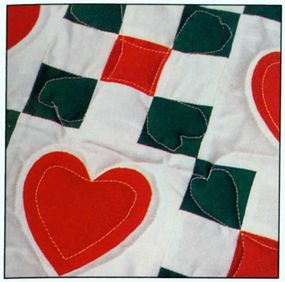Machine quilting doesn't have the same folksy reputation as quilting by hand, but it can make for a more visually dramatic quilt. The tension of the stitches creates more extreme peaks and valleys. Of course, it's also much faster to create a quilt with the help of a sewing machine.
Machine quilting is easy to learn, but it does take some practice. Make a few trial runs before starting to stitch on your completed quilt. On the test swatch, adjust the tension settings for the machine so that the stitches are even and do not pucker or have loose loops of thread.
Advertisement
The easiest machine stitching is long straight lines, starting at the center of the quilt and radiating out. These lines may be in a grid, stitched in the ditches formed by seams, outlines around design elements, or channels (long, evenly spaced lines).
Whatever the pattern, quilt from the center to the outer edges. Plan the order of stitching. Your plan should minimize the need to start and stop as much as possible.
Before placing the quilt on the sewing machine, roll the sides in toward the center and secure the rolls with pins or bicycle clips. Use an even-feed walking foot for straight lines of stitching. For freehand stitching, use a darning foot and lower the feed dogs or use a throat plate that covers the feed dogs.
To begin, turn the handwheel to lower and raise the needle to its highest point. Pull gently on the top thread to bring the bobbin thread up through the quilt. Stitch in place for several stitches. Gradually increase the length of each stitch for the first 1/2 inch of quilting until the stitches are the desired length. This will secure the ends of the threads, making it unnecessary to backstitch or knot them. Reverse these steps at the end of each line of quilting.
When quilting with the even-feed walking foot, place your hands on either side of the presser foot and apply an even pressure. Keep the layers smooth and free of tucks.
When doing freehand quilting, place your hands around the darning foot and apply gentle outward pressure to keep the layers smooth. Guide the fabric with smooth, even motions of the wrist. In freehand quilting, the fabric is free to move in any direction; it is not fed through the machine by the feed dogs. The stitch length is determined by the speed of the needle and the motion of the fabric under the needle. To keep the stitches the same length, maintain a steady speed and even motions. It takes some practice to get smooth curves and even stitch lengths using this technique, so don't be discouraged if your first attempts are a bit rough.

Advertisement
